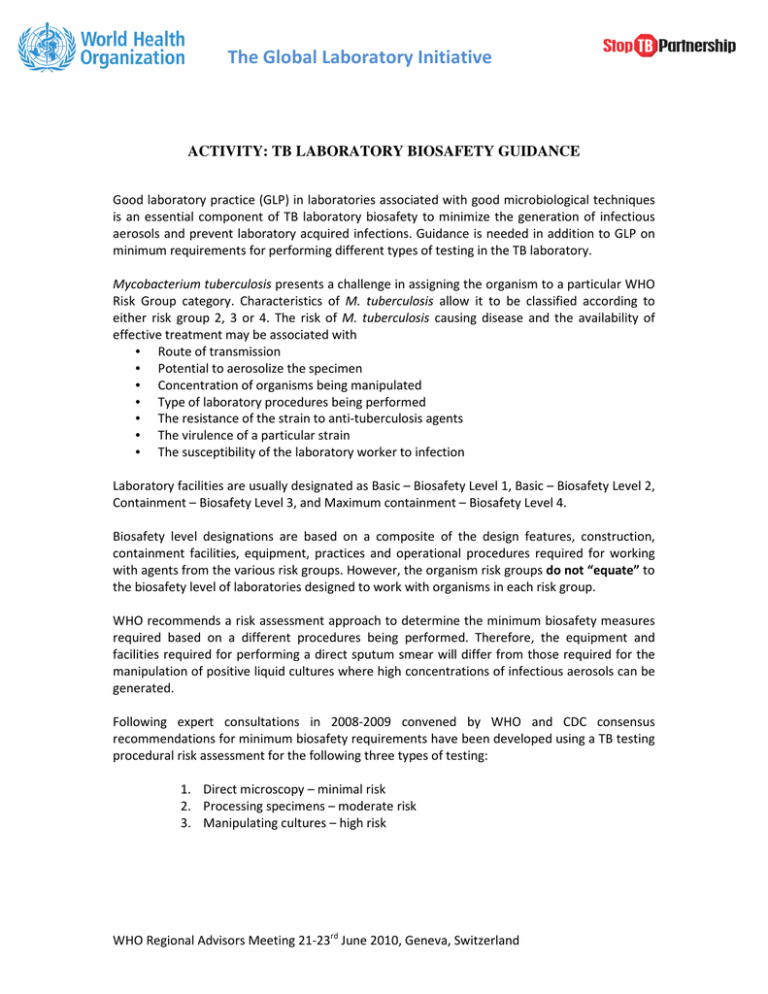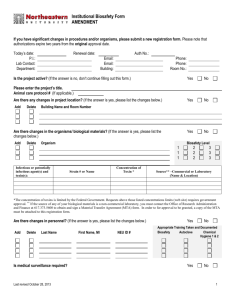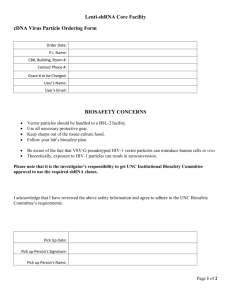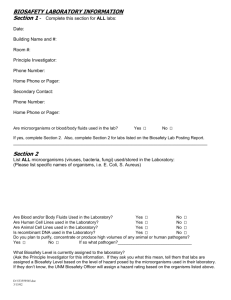The Global Laboratory Initiative ACTIVITY: TB LABORATORY BIOSAFETY GUIDANCE
advertisement

The Global Laboratory Initiative ACTIVITY: TB LABORATORY BIOSAFETY GUIDANCE Good laboratory practice (GLP) in laboratories associated with good microbiological techniques is an essential component of TB laboratory biosafety to minimize the generation of infectious aerosols and prevent laboratory acquired infections. Guidance is needed in addition to GLP on minimum requirements for performing different types of testing in the TB laboratory. Mycobacterium tuberculosis presents a challenge in assigning the organism to a particular WHO Risk Group category. Characteristics of M. tuberculosis allow it to be classified according to either risk group 2, 3 or 4. The risk of M. tuberculosis causing disease and the availability of effective treatment may be associated with • Route of transmission • Potential to aerosolize the specimen • Concentration of organisms being manipulated • Type of laboratory procedures being performed • The resistance of the strain to anti-tuberculosis agents • The virulence of a particular strain • The susceptibility of the laboratory worker to infection Laboratory facilities are usually designated as Basic – Biosafety Level 1, Basic – Biosafety Level 2, Containment – Biosafety Level 3, and Maximum containment – Biosafety Level 4. Biosafety level designations are based on a composite of the design features, construction, containment facilities, equipment, practices and operational procedures required for working with agents from the various risk groups. However, the organism risk groups do not “equate” to the biosafety level of laboratories designed to work with organisms in each risk group. WHO recommends a risk assessment approach to determine the minimum biosafety measures required based on a different procedures being performed. Therefore, the equipment and facilities required for performing a direct sputum smear will differ from those required for the manipulation of positive liquid cultures where high concentrations of infectious aerosols can be generated. Following expert consultations in 2008-2009 convened by WHO and CDC consensus recommendations for minimum biosafety requirements have been developed using a TB testing procedural risk assessment for the following three types of testing: 1. Direct microscopy – minimal risk 2. Processing specimens – moderate risk 3. Manipulating cultures – high risk WHO Regional Advisors Meeting 21-23rd June 2010, Geneva, Switzerland The Global Laboratory Initiative Direct AFB Microscopy Limited risk of generating infectious aerosols Key Recommendations: • Work can be done on an open bench • Access to the laboratory needs to be restricted • Separate bench for smear-preparation required • Adequately ventilated laboratory with 6-12 air changes per hour (ACH) with unidirectional airflow with either natural or mechanical ventilation. • Proper disposal of infectious material Processing sputum specimens for culture inoculation and/or direct molecular tests Moderate risk of generating infectious aerosols during centrifugation and specimen manipulation Key Recommendations: • • • • Laboratories must have restricted access and be separated from public areas Impermeable surfaces for easy cleaning Air flows into lab without re-circulation to non-lab areas (directional airflow) – 6-12 ACH, passive or mechanical ventilation – closed windows – All work MUST be performed within a certified Biological Safety Cabinet preferably ducted to the outside using a thimble connection Proper disposal of infectious material Manipulating cultures for smear preparation, identification tests, DST, or molecular tests High risk of generating infectious aerosols during manipulation of liquid suspensions Key Recommendations: • • Perform ALL work in a containment laboratory Laboratory biosafety requirement in the containment laboratory MUST meet all of those described for processing sputum specimens plus the following additional requirements : – The laboratory must be a containment laboratory with double door entry. Note: Sealing of the room for fumigation purposes is NOT required – Autoclave available on site Experts have agreed to specify the minimum standards for TB facilities without assigning a biosafety level 1, 2 or 3, according to the risk-based approach recommended in the CWA 15793:2008 laboratory biorisk management standard. Therefore the term BSL-3 level laboratory is expected to become redundant for describing minimum biosafety measures needed in a TB laboratory. Formal WHO policy guidance on TB laboratory biosafety is expected by the end of 2010. WHO Regional Advisors Meeting 21-23rd June 2010, Geneva, Switzerland






